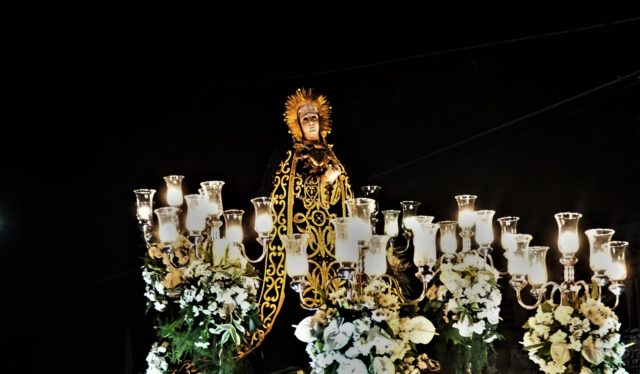NO, THE observance of the Holy Week has not been cancelled. The Holy Masses and liturgical ceremonies will go on, albeit within the confines of churches, absent the congregation. But not without their attendance, if only via livestream or through Facebook.
For the Catholic faithful, especially in Pampanga, it will be the first time that the Semana Santa will not be what they were born and bred in. Here’s a piece — Maleldo: Passion and pageantry – of how it was – at least in my hometown of Sto. Tomas – written a few years back.
Maleldo. A contraction of mal a aldo – directly translating to a highly-valued, hence, holy day – has evolved to be the one word comprising the Holy Week and all its rituals. Maleldo is intertwined with kaleldo – summer, the season when it is observed.
The etymology of Maleldo is easy enough to explain. The rituals and practices exclusive to the town of Sto. Tomas are a different thing.
In the absence of written history, the oral tradition – kuwento ni lola – is the only source of information on the rituals of maleldo.
From the Canlas sisters – Apung Mameng (1898-1976) who remained unmarried, Apung Rita vda de Zapata (1901-1980), Apung Bibang vda de Manese (1903-1978) – came the information written here, passed on to them by their mother Demetria.
“Ding apu (grandmother) nang ima mi mig-sagala nala kanu king maleldu,” the sisters were wont to say to their inquisitive grandchildren at the time.
The Holy Week starts with Viernes Dolores, later moved to Sabado Dolores. The change came in the late ‘60s or early ‘70s – somewhere at the tail end of the Cursillo Movement — to “circumvent” the rigid abstinence of no-meat-on-the-Fridays-of-Lent.
A triumvirate of women handles the activities: the Hermana Mayora, the Mayordoma and the Secretaria. The three fetch the image of the Mater Dolorosa from the house of the camadera in Barangay San Bartolome and head the procession to the church on Viernes Dolores.
Sabado Dolores
The day starts with a morning Mass followed by a breakfast – courtesy of the Secretaria — for the Mass-goers on the church grounds.
At lunchtime, presided by the Hermana, the saladoras – a group comprising of previous hermanas, mayordomas, secretarias, as well as descendants of those who served as such but have long gone – gather to choose the successors to the three oficiales.
Choice per position is through bola-suerte. Two jars are used: one contains rolled pieces of paper on which are written the names of the candidates; the other, rolled papers commensurate to the number of candidates – all blank but for one with the word suerte. The name of the candidate drawn from the first jar that matches the suerte from the second jar becomes the hermana, mayordoma, or the secretaria.
In the evening, the image of the Mater Dolorosa is venerated in a procession around town with the hermana and her court, escorted by their husbands, preceding the caro.
The procession marks the debut appearance of the estabats – twelve young lasses that make a choir, accompanied by a manggirigi – a violinist – as they sing hymns to the Blessed Virgin.
Estabats
The estabats are so-called after the opening lines of their Latin hymn “Stabat Mater Dolorosa…” roughly translated to “the Sorrowful Mother was standing…”
Supervision of the Holy Week celebrations shifts from the hermana to a Holy Week Executive Committee after the Sabado Dolores. The committee chair is selected each year and is given the freehand to choose his officers and members.
Domingo de Ramos — Palm Sunday — comes with the traditional blessing of…well, palm and olive branches in a barrio chapel – alternately in San Bartolome and San Vicente – followed by a procession to the parish church with the parish priest taking the role of Christ on the way to Jerusalem accompanied by twelve men acting and dressed in the role of the 12 Apostles.
At the four corners of the churchyard or the street fronting the church stand kubu-kubuan where choir members sing hosanna and shower the priest with petals and confetti. The celebration ends with a Mass.
Lunes Santo and Martes Santo were quiet days. Until the cenaculo or reading of the Passion was moved to Martes Santo and Miercoles Santo.
Originally, the cenaculo was held on Maundy Thursday and Good Friday. In the ‘70s, it was moved to Holy Wednesday and Maundy Thursday, to give full contemplation on the suffering and death of Christ on Good Friday. Sometime later it was further moved to where it is now being celebrated.
Traditionally, the cenaculo is an affair of the youth. A president from each gender gets elected to chair the festivity which comprises of the reading of the Passion and the serving of — variably, depending on the collections – ice cream and barquillos or kalame. Of late, the word cenaculo has given way to the Tagalog pabasa. A more appropriate term, so the purists hold, given that a cenaculo goes beyond mere reading of the Passion to include a play or a drama of the Passion.
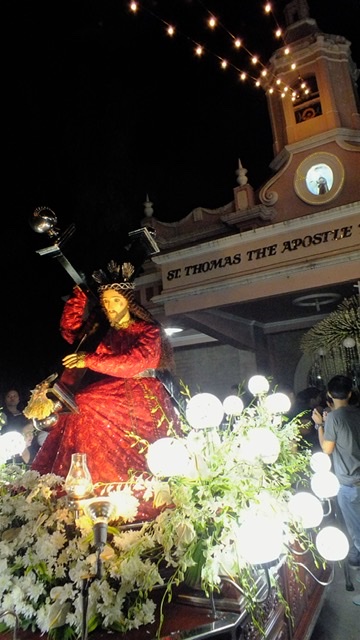
The second procession of the week takes place in the evening of Miercoles Santo. Here, images of saints who had had participation in the days prior to the death of Christ are put on decorated caros with St. Peter, bearer of the keys to heaven and his ubiquitous rooster at the lead followed by St. John the Evangelist, St. Thomas, St. Bartholomew, St. Andrew, St. Philip, St. James, St. Mary Magdalene, St. Veronica, St. Martha. Second to the last is the image of the Nazareno, Jesus carrying the cross, followed by the apostoles. The image of the Mater Dolorosa is at the rear, preceded by the estabats and followed by the brass band.
Camaderas
In between the caros are the cofradias and church organizations and the camaderas, the owners or caretakers of the images.
Maundy Thursday marks the observance of the washing of the feet of the apostles and the Last Supper. The parish priest is assisted by the Holy Week Committee chair and officers at the foot-washing rites.
After the ceremonies, the parish priest and the apostoles take their own supper at the parish rectory and partake of the cordero, a dish of beef covered with potatoes shaped like a lamb.
Rites and ceremonies for Good Friday start shortly after noon with the Las Siete Palabras, homilies and meditation on the final seven utterances of Christ at Calvary, which end at 3:00 in the afternoon, traditionally believed to have been the hour of Christ’s death.
Tanggal, a dramatization in song and verse of Christ’s body being taken down from the cross, used to follow the Las Siete Palabras. The last staging of tanggal was held in 1979.
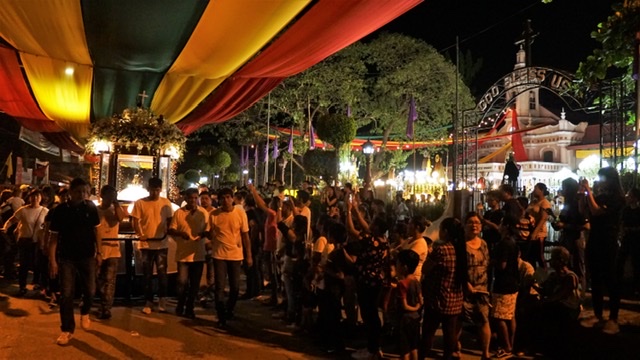
Taking centerstage in the Good Friday procession is the Santo Entierro. It has become a tradition for the faithful to pluck out all the flowers decked in the caro as soon as it enters the church after the procession. Some claim miraculous attributes to the flowers.
At the procession, the estabats sing mournful hymns and dirges in reflection of the pain and anguish suffered by the Mater Dolorosa over the death of her son.
Sabado de Gloria is highlighted by the evening Mass with the blessing of the fire and water as well as the renewal of the baptismal vows.
Domingo de Pascua – Easter Sunday – marks the climax of the Holy Week celebrations in more ways than spiritual, folk art, aesthetics, socials melding into it.
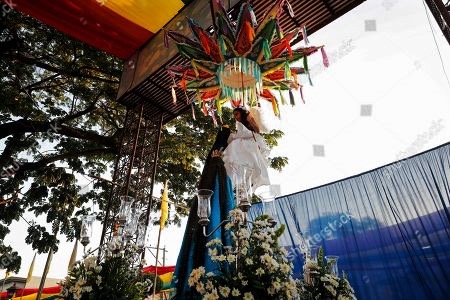
Pusu-puso
Before 6:00 in the morning, the faithful gather at the churchyard for the Salubong, the first meeting between the Risen Christ and the Blessed Mother.
Under a pusu-puso, a veiled image of the Virgin Mary faces – behind a curtain – the image of the Risen Christ. The pusu-puso opens gradually, raining in petals and confetti on the images. At its final opening, comes out a young girl dressed as an angel in a kalo, an improvised swing, singing “Regina Laetare, Alleluia” as she is lowered down to take the veil off the Blessed Mother. At this, the curtain parts, the brass band plays and the faithful applaud to mark the start of the procession.

At the head of the procession are the ciriales, bearer of the ceremonial cross and candles in the person of three ladies in their fineries with their escorts in barong. They are followed by the banderada, the bearer of the Vatican flag.
Sometime in the ‘80s, mini-sagalas were introduced. These are little girls dressed as angels to accompany the incensario, the bearer of the incenser and the incense boat, and the angel who took the veil off the Blessed Mother.
Next come the estabats, singing glorious hymns and raining petals on the Atlung Maria at designated stops along the processional route.
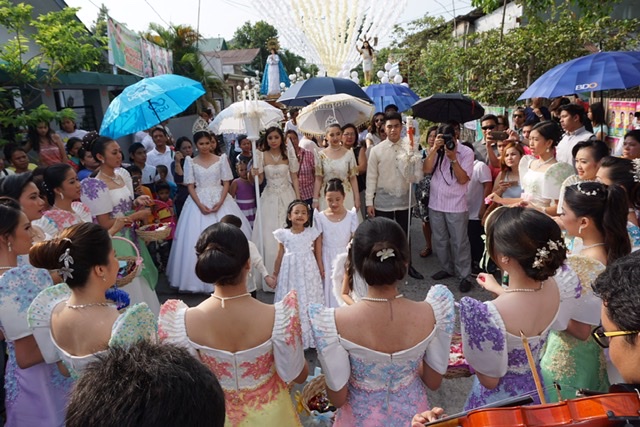
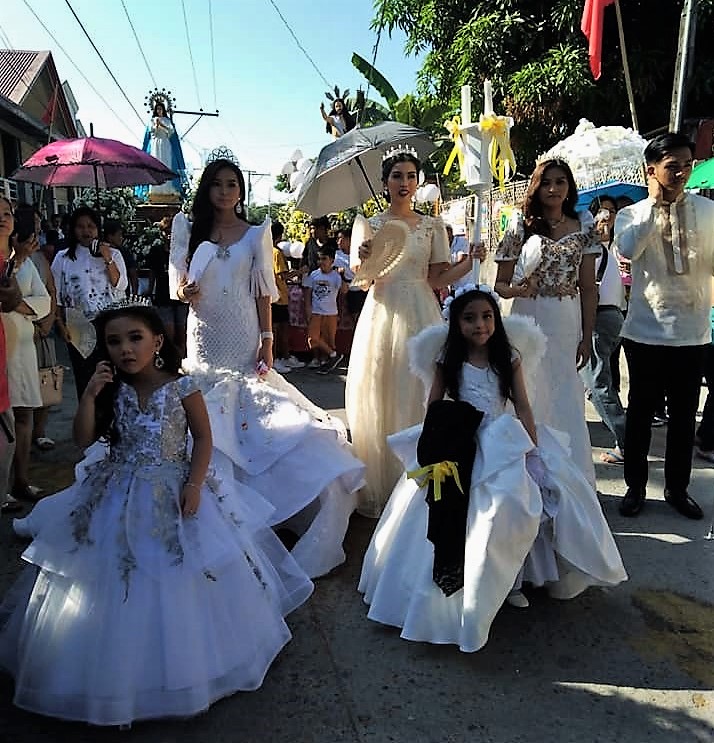
The Atlung Maria symbolize the Virgin Mother, Mary Magdalene and Mary Cleofas. By tradition, the center – the spot of the Virgin – is reserved for the most beautiful of the three sagalas. It is therefore a most coveted spot. Sagalas for the Atlung Maria are exclusive to ladies born and bred in Sto. Tomas or those whose ancestry can be traced to the town. In the social milieu, no lady from Sto. Tomas is truly beautiful unless she has been one of the Atlung Maria.
With the Atlung Maria is the Ciru Pascual, the bearer of the Paschal Candle, always a local bachelor and one whose bloodline comes from the town.
The images of the Risen Christ and the Blessed Mother bring the rear of the procession which ends with a High Mass.
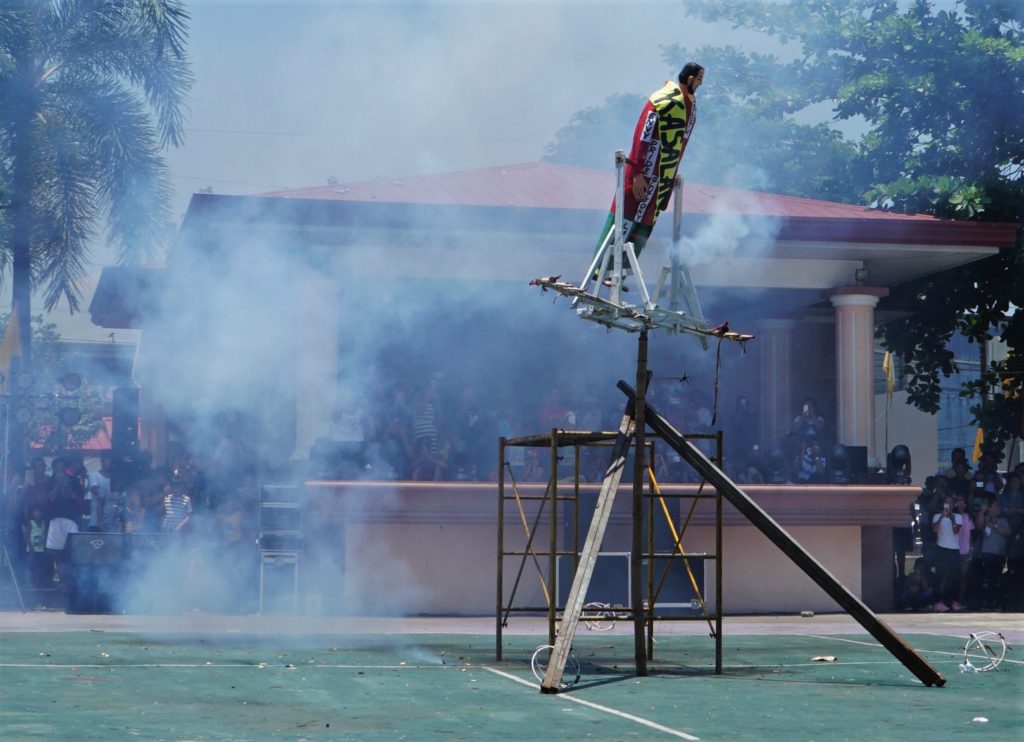
Blasting Judas
After the Mass, the faithful congregate anew at the churchyard for the burning – exploding is more apt here – of an effigy of Judas Iscariot.
Atop a scaffolding, Judas is ignited by pyrotechnic ravens and then twists, turns upside down, rotates and starts exploding from the legs up the arms, the body and lastly, the head with the loudest bang.
Lost in some vengeful glee among the faithful is the meaning behind the burning of Judas: That spiritually renewed with the fire and water of Sabado de Gloria, restored in grace with the Risen Christ, the faithful should cast away all vestiges of sin, of spiritual shortcomings with Judas and burn them away. This is no less a form of a holocaust offered to God. The very essence of the celebration of the Holy Week.
Mayhaps, it is with that thought that in 2010, the Judas effigy made way for an unnamed human form marked with the seven deadly sins. Still complete with the blasting though. In the following years, the human form was totally discarded in favour of a papier-mache globe likewise marked with the seven deadly sins, which blasting symbolize the liberation from worldly sins and the salvation of mankind. Indeed, a more apt metaphor obtaining there than in the seeming scapegoating with the Judas effigy. Two years after, Judas was back though
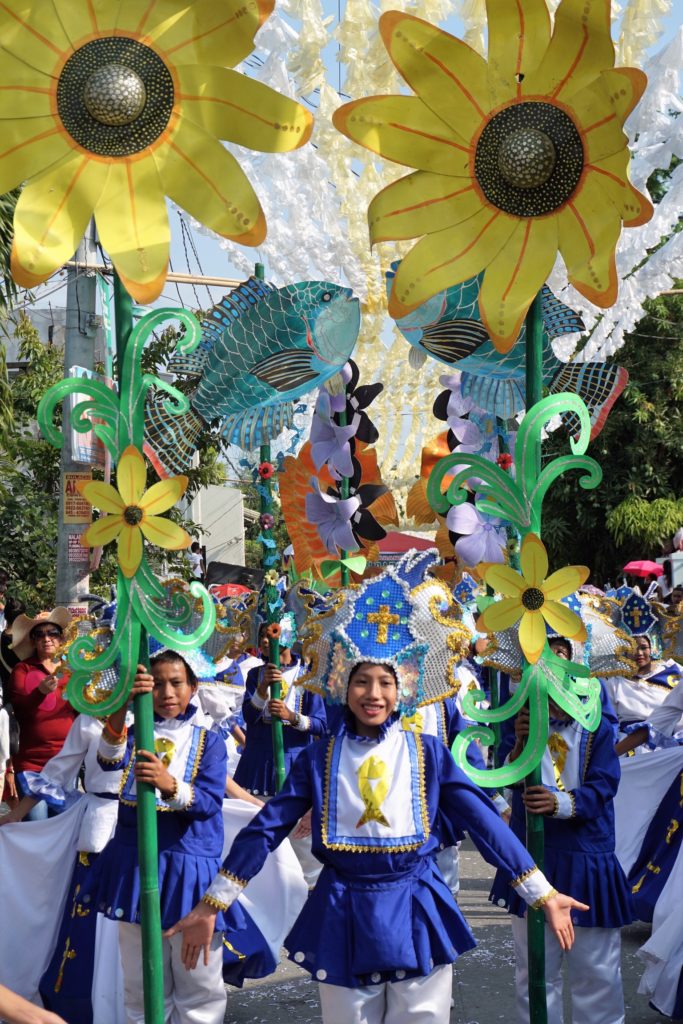
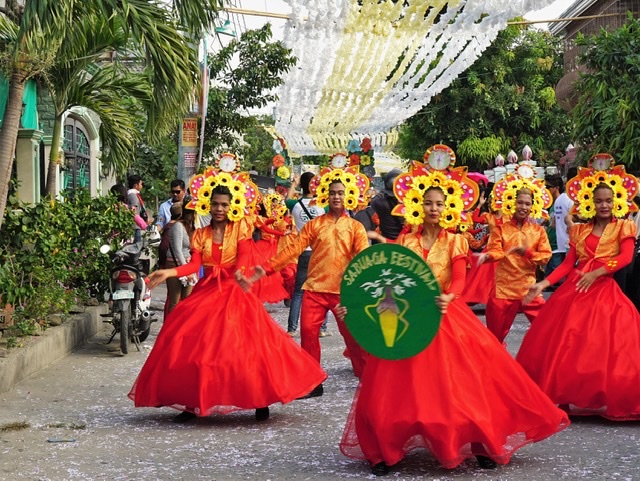
Sabuaga
In 2010 too, the loud bang of the seven deadly sins ceased to be the closing act of the annual Holy Week celebrations in Sto. Tomas. To the old rites was added the Sabuaga Festival.
Sabuaga comes from the combination of sabuag (scatter) and sampaga (flowers) – the sagalas’ showering of petals on the image of the Virgin Mary in “veneration of her keeping the faith and oneness with her Son in His sufferings, thus her rewards in His joyful resurrection.”
Petals and confetti literally rain on the processional route around Poblacion, starting 2 p.m. of Easter Sunday as revelers join groups coming from the town’s seven barangays in street dancing.
At the town plaza where the revelry culminates, the groups in their most exotic costumes reflective of the product of the barangays they represent will each do its own interpretative dance presentation, on the theme sabuag sampaga, naturally. Judges coming from the arts, culture and tourism sector will proclaim the winners.
A trade and industry component to the festival is provided by the town’s one-barangay-one-product exhibit around the town plaza, with each barangay displaying its produce, notably the pottery and ceramics of Sto. Niño, and the caskets of San Vicente.
Sto. Tomas is known as the casket capital of Central Luzon, if not of the whole country, having at one time supplied funeral parlors throughout the whole archipelago and even nearby Asian countries.
In effect, Sabuaga serves as a one-stop showcase of the spirituality, culture, and industry of the people of Sto. Tomas.
Sabuaga serves too as a fitting climax to the Holy Week celebration in Pampanga, being the last major event of the season.


